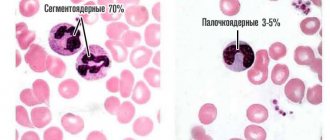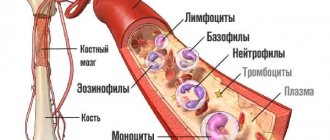Aplastic anemia is a disease characterized by peripheral pancytopenia. That is, this is a condition in which a person’s bone marrow stops producing a sufficient number of blood cells.
With aplastic anemia, there is a deficiency of all types of cells: red blood cells, white blood cells and platelets.
Bone marrow is a peculiar structure that is located in the bone canal. It is responsible for the formation of all blood cells in order to supply the body with oxygen, fight infection and ensure blood clotting. And if malfunctions occur in its work, or bone marrow cells are damaged by various factors, they stop producing new blood cells and aplastic anemia develops.
Most often it develops in young people and children, from 10 to 20 years. But sometimes there is another peak in the development of the disease at 60 years of age. The prevalence is approximately the same between men and women.
(https://www.cinj.org/sites/cinj/files/documents/December%20National%20Aplastic%20Anemia%20Awareness%20Month%202018.pdf)
Aplastic anemia was first described by the German scientist Paul Ehrlich in 1888. He conducted research into the cause of death of a young pregnant woman who died quite suddenly. At the autopsy, the doctor saw that there was no normal tissue in the intradermal space. It was replaced by fat. Then he suggested that this was one of the most severe diseases of hematopoiesis. True, the term “aplastic anemia” was used only in 1904 by the French hematologist A. M. Shoffard
What is pancytopenia?
Pancytopenia is a descriptive term for a combination of low levels of all types of blood cells, including red blood cells (anemia), white blood cells (leukopenia), and platelets (thrombocytopenia). Often, symptoms such as fatigue, infections and bruising occur as a result of decreased levels of these cells.
There are a number of different conditions that can cause pancytopenia, including bone marrow diseases, some types of cancer, and some infectious diseases. Medical conditions such as chemotherapy can also cause pancytopenia.
Treatment options for pancytopenia depend on the specific cause and typically focus on increasing cell levels to improve symptoms while treating the underlying cause.
Symptoms of pancytopenia - deficiency of morphotic blood elements
There are three main groups of blood cells in the blood: red blood cells, which deliver oxygen to all tissues, white blood cells, which fight infection and form our protective barrier, and platelets, which are responsible for stopping bleeding and closing wounds.
Symptoms of pancytopenia occur due to too few of these cells and hence their dysfunction. Due to the complex nature of this disease, a range of symptoms may be experienced and may vary in severity.
About
Blood cells affected by pancytopenia
Specifically, pancytopenia refers to a deficiency of:
- Red blood cells (erythrocytes): Red blood cells are cells that bind and carry oxygen to body tissues.
- White blood cells (leukocytes). There are several types of white blood cells, which are further broken down into granulocytes (including neutrophils, eosinophils and basophils) and agranulocytes (including lymphocytes and monocytes). These cells are responsible for fighting infections among other functions.
- Platelets: Platelets are responsible for blood clotting.
Description of Low Blood Cell Count
These terms are used for lower levels of blood cells:
- A low level of red blood cells is called anemia. It is important to note that there are different forms of anemia. One form is low red blood cell count, but it can also be due to blood loss, low hemoglobin levels, vitamin B12 deficiency, and other causes.
- Low levels of white blood cells are referred to as leukopenia (you may also have heard of neutropenia, which refers to low levels of a certain type of white blood cell known as neutrophils).
- Low platelet levels are called thrombocytopenia, and there is immune thrombocytopenia or chemotherapy-induced thrombocytopenia.
Symptoms of aplastic anemia
Aplastic anemia has no specific symptoms. Doctors evaluate all complaints as a whole and only then can they suspect the disease.
Since with aplastic anemia there is a lack of a full number of all blood cells, the symptoms appear as a result of the failure to perform their functions.
The absence of red blood cells means that the body does not receive the necessary microelements, and more importantly, oxygen. This will lead to:
- Constant weakness, fatigue and loss of ability to work;
- Headache and dizziness;
- Pallor of the skin;
- Shortness of breath;
- Persistent tachycardia.
The loss of white blood cells will lead to a decrease in immune defense, which means it may manifest itself:
— Frequent infectious diseases;
- - fever;
And when the number of platelets decreases, the blood clotting function is lost, and the symptoms of this will be:
- The appearance of bruises, even with the slightest physical impact;
- Appearance of petechiae;
— Presence of a red rash on the body;
- Prolonged bleeding from small wounds that is difficult to stop;
- Bleeding from the gums while brushing your teeth or eating.
The disease can take quite a long time to develop. Hematopoiesis is not completely switched off; its function decreases gradually. And at first, the patient does not feel any symptoms, as the body compensates and works normally, albeit with fewer cells. But over time, cell reserves and depots are depleted, and the bone marrow continues to lose its function and then the symptoms begin to increase. Sometimes, people do not understand what exactly is happening and self-medicate at home, which only leads to a worsening of the condition. And when cell levels are critically low, emergency conditions arise.
Lab tests
Pancytopenia is usually diagnosed by a complete blood count (CBC).
In pancytopenia, the CBC will show insufficient levels of all types of blood cells, including:
- The red blood cell count is less than 4.2 million cells per cc in women or less than 4.7 million cells per cc in men (this may also be described by low hemoglobin levels).
- The leukocyte count is less than 4,000 leukocytes per cubic cm (normally, a person has from 4,000 to 10,000 leukocytes per cubic cm).
- Platelet count is less than 150,000 cells per cubic cm (normally from 150,000 to 400,000 cells per cubic cm).
Causes of pancytopenia
Pancytopenia can be caused by anything that prevents blood cells from being made in the bone marrow or from appearing in the bloodstream (for example, if they are retained by the spleen).
This may include destruction of the bone marrow by toxins, suppression of the bone marrow, such as during chemotherapy, or the replacement of bone marrow cells with others that interfere with the production of blood cells, during treatment for certain cancers. Destruction or suppression can occur as a result of inflammation, infection or autoimmune diseases.
Most of these conditions are acquired later in life, but some are inherited and passed on from birth. In at least 50 percent of cases, there is no obvious cause—what doctors call an “idiopathic” cause. Some of the possible causes of pancytopenia may be:
- chemotherapy caused by bone marrow suppression;
- induced drugs: drugs other than chemotherapy have been cited as causes, ranging from antibiotics to drugs used for cardiovascular disease;
- infections such as infectious mononucleosis and HIV, as well as suppressive infections (sepsis);
- aplastic anemia;
- splenic sequestration (holding of blood cells by the spleen so they can travel to the rest of the body);
- toxins and chemical exposures, such as exposure to arsenic or benzene;
- blood cancer in the bone marrow, such as leukemia, lymphoma, myeloma, or metastatic bone marrow cancer;
- metastasis of some solid tumors to the bone marrow, especially breast cancer, prostate cancer, colon cancer, gastric cancer and melanoma. In bone marrow metastases, the most common symptom is anemia followed by thrombocytopenia;
- myelodysplastic syndromes of “precancerous” conditions of the bone marrow;
- autoimmune disorders such as lupus erythematosus;
- radiation sickness;
- hereditary syndromes such as Fanconi anemia and Diamond-Blackfan anemia.
Most common reasons
A 2014 study aimed to determine the most common causes of pancytopenia in people who had not yet been diagnosed with the disease. For example, none of these adults had received chemotherapy or had an obvious cause of pancytopenia. Of these people:
- more than 60 percent had some type of blood cancer. The most common were acute myeloid leukemia, myelodysplasia, non-Hodgkin's lymphoma, hairy cell leukemia, and acute lymphocytic leukemia;
- among those whose blood cancer was not associated with a cause of pancytopenia, diagnoses included aplastic anemia, pernicious anemia, and HIV.
Thrombocytopenia
HIV
Hepatitis
Iron deficiency
18347 August 12
IMPORTANT!
The information in this section cannot be used for self-diagnosis and self-treatment.
In case of pain or other exacerbation of the disease, diagnostic tests should be prescribed only by the attending physician. To make a diagnosis and properly prescribe treatment, you should contact your doctor. Thrombocytopenia: causes of occurrence, in what diseases it occurs, diagnosis and treatment methods.
Definition
Platelets are plate-shaped blood cells that participate in blood clotting processes. Their main function is to close a wound when bleeding by forming a thrombus, or blood clot. Thrombosis is a natural process of protection against massive blood loss in any injury. A deficiency of platelets in the blood is called thrombocytopenia. This condition is often asymptomatic, but can be life-threatening if the number of blood platelets decreases significantly.
In addition to stopping bleeding (hemostasis), platelets perform a number of important functions in the human body: releasing substances that constrict blood vessels during bleeding; stimulation of tissue repair in case of any injury; regulation of local inflammation and immunity processes.
These functions are activated when there is any damage to the endothelium (the inner layer covering the walls of blood vessels). A lack of platelets leads to a disruption of the blood coagulation system and, as a result, increased bleeding, hematomas (bruises) and a dark red rash on the skin and mucous membranes (this rash does not disappear with pressure).
Prolonged bleeding of the gums, large amounts of bleeding from small wounds and during menstruation are an alarming signal indicating a possible problem with the blood coagulation system.
Types of thrombocytopenia
Thrombocytopenia is understood as a decrease in the number of platelets in the peripheral blood below 150 thousand/μl. Among all thrombocytopenias, the following conditions are distinguished:
- Dilution thrombocytopenia - occurs with massive bleeding and replenishment of the circulating blood volume with solutions.
- Thrombocytopenia of distribution - often occurs with excessive pathological utilization of platelets in an enlarged spleen.
- Productive thrombocytopenia occurs when bone marrow function is impaired as a result of various diseases or radiation therapy.
- Thrombocytopenia of consumption - occurs with DIC syndrome (disseminated intravascular coagulation - a pathological condition when blood clots form in the bloodstream of many organs) or with constant autoimmune damage to the vascular endothelium. There is a pathological activation of platelets and their rapid consumption (consumption) by the body.
- Pseudothrombocytopenia occurs when the analysis technique is violated with the development of platelet aggregation.
Possible causes of thrombocytopenia
One of the common causes of thrombocytopenia is excessive platelet consumption
in the body, for example, with DIC syndrome.
Immune form of thrombocytopenia
is considered the most common immune blood pathology. It develops quickly, with a rise in body temperature and the appearance of a profuse rash on the skin of the lower extremities, buttocks, around large joints, sometimes reaching the face. The rash consists of small hemorrhages in the skin, often accompanied by joint pain, swelling, and loss of movement in the affected joints. Sometimes it manifests itself as cramping abdominal pain, nausea, vomiting and loose stools. Cases of blood appearing in the urine have been described.
Autoimmune thrombocytopenia
(idiopathic thrombocytopenic purpura, Werlhof's disease) is caused by a decrease in platelet lifespan due to the effects of antiplatelet autoantibodies. Such thrombocytopenia can occur in waves, with alternating periods of exacerbation and remission. Often the disease makes itself felt against the background of infectious diseases: influenza, human immunodeficiency virus (HIV), Epstein-Barr virus (EBV), parvovirus B19, cytomegalovirus infection (CMV), viral hepatitis B and C.
Among productive thrombocytopenias
Aplastic anemia, tumor processes in the bone marrow, and radiation injuries occupy a special place.
All of these conditions are characterized by a sharp decrease in the hematopoietic (hematopoietic) function of the bone marrow due to certain structural changes.
Aplastic anemia
is characterized by a decrease in the production of all three hematopoietic lineages: red blood cells, leukocytes and platelets. Each germ is responsible for specific functions in the body, and a decrease in the cells produced leads to the appearance of corresponding symptoms. A decrease in platelets leads to increased bleeding, a decrease in the number of red blood cells indicates signs of anemia (pallor, fatigue, brittle hair, chest pain), and a decrease in leukocytes leads to infectious complications in the form of recurrent sore throats, pneumonia, etc. In some cases, the bone marrow is replaced by fatty tissue tissue, which also disrupts the formation of blood cells.
For B12 and folate deficiency anemia
the maturation of future platelets is disrupted; they die even before the maturation stage. The disease is manifested by pale skin, rapid heartbeat, and shortness of breath. With a severe deficiency of vitamin B12, sensory disturbances, paresis and paralysis are possible.
Different types of leukemia
lead to the appearance of tumor cells, which divide at tremendous speed and soon replace the bone marrow. In this case, the function of all three hematopoietic germs is disrupted. Immature cells appear in the bone marrow and blood, unable to perform their function.
Drug-induced thrombocytopenia
may develop as a result of taking certain medications, for example, cytostatics, which inhibit platelet formation in the bone marrow.
Diseases accompanied by an increase in the size of the spleen
(splenomegaly) can lead to increased destruction of platelets, or hypersplenism (increased platelet utilization by the spleen). In addition to platelets, red blood cells are also destroyed, which leads to the development of not only a thrombocytopenic state, but also to hemolytic anemia.
Such diseases include liver cirrhosis, including alcohol etiology, chronic heart failure, and lymphoproliferative diseases.
Which doctors should you contact if you have thrombocytopenia
? The diagnosis of thrombocytopenia is established using laboratory tests. Most often, patients who subsequently develop thrombocytopenia come to us with complaints of increased bleeding, rash, malaise, and fatigue. If a decrease in platelet count is detected, the therapist will prescribe a consultation with a hematologist. In some cases, consultation with a hepatologist or rheumatologist is required.
Diagnosis and examinations for thrombocytopenia
If signs of thrombocytopenia are detected, the doctor will prescribe a set of laboratory and instrumental research methods:
- clinical blood test: general analysis with platelet count, leukoformula, ESR (with blood smear microscopy in the presence of pathological changes);
Symptoms and signs
Symptoms of pancytopenia may include a weak or enlarged spleen, in addition to symptoms and signs associated with a deficiency of specific blood cells. Some of these symptoms include:
- symptoms associated with anemia (low red blood cell count), including pallor, fatigue, fast heartbeat (tachycardia), and shortness of breath;
- symptoms associated with leukopenia or neutropenia (low white blood cell count), including fever and signs of infection such as cough or pain when urinating;
- symptoms associated with thrombocytopenia (low platelet levels), including easy bruising and heavy bleeding (see photo above).
Diagnostics
Pancytopenia can be detected by a complete blood count (CBC). The first step in assessing low levels of all cells is to repeat a complete blood count. A peripheral blood smear is then taken to further look at each of the different cell types.
If a repeat CBC confirms that you do have pancytopenia, the second step is to perform a bone marrow biopsy.
Bone marrow aspiration and biopsy examine components of the bone marrow, which include hematopoietic stem cells (cells that differentiate into all the different types of blood cells), blood cells at various stages of maturation, and materials used to make blood cells, such as iron and vitamin B12 .
In addition to testing the level of B12 in the blood, special tests and tests are done on the cells to look for changes such as chromosomal and genetic changes that are common in leukemia.
Diagnosis of pancytopenia – morphology and bone marrow biopsy
If pancytopenia is suspected due to alarming symptoms, the first test is a blood test.
According to the guidelines, a doctor may suspect pancytopenia if the number of red and white blood cells and platelets is below normal. As a result, low hemoglobin, low hematocrit, and granulocyte deficiency may occur.
If the suspicion of pancytopenia is confirmed, your doctor may order additional tests to determine the exact cause, ranging from more detailed blood tests to taking a bone marrow sample.
Bone marrow biopsy is usually performed to rule out neoplastic infiltration in patients in whom the cause of pancytopenia is difficult to determine.
Treatment of pancytopenia
The goal of treating pancytopenia is to identify and treat the underlying cause. If the cause is unknown or expected, such as with chemotherapy, treatment is aimed at minimizing symptoms associated with a blood cell deficiency. Some treatments that may be used include:
- Bone marrow stimulating drugs. For neutropenia caused by chemotherapy and some other causes, the growth factors Leukine, Neupogen or Neulasta can be used to stimulate the production of white blood cells. To treat anemia caused by chemotherapy, there are also some medications that can be used by doctors.
- Blood transfusions.
- Immunosuppressants if the condition is associated with an autoimmune disease.
- Bone marrow or stem cell transplant.
Etiology of aplastic anemia
Most often, this is an acquired disease that occurs during life and is not inherited.
It is quite difficult to find the exact cause of the development of aplastic anemia, since in everyday life we encounter many factors that can affect the functioning of the bone marrow.
Scientists identify the main triggers that can become a trigger:
* Exposure to various chemicals. Some substances used in pesticides, benzene, chlorines, nitrates, can damage bone marrow.
* Various radiations. Radiation, magnetic, etc. have a bad effect on the functioning of the entire body and can lead to the bone marrow not being able to cope with the load.
* Presence of viral diseases. About 2% of patients with viral hepatitis suffer from aplastic anemia. This also includes cytomegalovirus, HIV, Epstein-Barr and parvoviruses. https://www.nejm.org/doi/full/10.1056/nejm199705083361906
* Pharmacological drugs and some treatment methods. For example, some strong antibiotics, chemotherapy drugs and radiation therapy.
* Autoimmune diseases. This is a pathological condition when your own immune system begins to attack the cells of your body. In most cases, the bone marrow is also affected
One of the risk factors for development is a family history. Actually, if there have been cases of aplastic anemia in the family, then under the influence of triggers it can develop.









